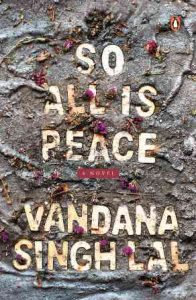So All Is Peace, Is a Protest!
A Book Review – So All Is Peace, author Vandana Singh Lal. It is not about the protest! It is a story of twin sisters.

Delhi, despite facing the severest of the winters in two decades, is full of life! It is all set to welcome the New Year, 2020, in a brave way. Tens of thousands of young Delhites across classes, beating the winter, are marching from Mandi House to Jantar Mantar for a public cause. And previously and after, at Jamia, thousands of students from three Universities of Delhi gathered to demand the restoration of secularism. Showing them solidarity were hundreds of families, some of them with children. And then at Shaheen Bagh, a cohesive urban slum community is standing up for their rights, with women leading the protests, for many nights and days now. Then not to mention about Jama Masjid, where thousands converged giving a rights-based salute to themselves, the protestors and their cause. This is the captivating Delhi full of young people demonstrating responsible citizenship and fulfilling their fundamental duty towards the nation. And those with power and holding responsibilities preaching them to be ‘responsible by being submissive’—a new normal narrative for students these years. Their right to protest is being sanitised—in the name of Need for Peace. The protestors very well know that Protest is mostly non-violent and Peace can be completely violent.
It is an irony that the book I took to read was titled, So All Is Peace. It is not about the protest, nor about secularism or the freedom of expression. It is a story of twin sisters; one is injured and hospitalized while the other is in ICU. The story unfolds locating the protagonists amidst various duty-bearers, hospitals, police, media and RWA—how these institutions fall victim of contemporary moralities. For young protestors, the Citizen Amendment Act has a similar context. It has been the major assault on secularism. And Secularism’s twin sister, the Freedom of Expression, has been in the ICU for sometime now. The situation of the twin sisters of secularism and freedom of expression is no different than that of Vandana Singh Lal’s twin-character sisters, Tanya and Layla. And the Novel, so filled with exuberance, is no different from the four-hour protest march from Mandi House.
Also Read : My Fathers Garden A Poignant Tale Of Love Truth And Identity
One could feel in the novel the author’s personal politics protesting against the social milieu characterized by patriarchy, neoliberalism, consumerism and class-caste discriminations; a protest that pierces current reassured moralities that govern the society. The book itself is a protest.
The book takes you back to the ‘now-old’ Delhi—all of power, hierarchies and patriarchies. The Delhi that is notoriously known for. While the book is not about Delhi-bashing, it depicts carefully evolved characters living amidst patriarchy, power-hungry society, manipulative media and moralistic society. All characters seem to have agency, but they all are floating on a fluid that is very moralistic, yet judged through a well-calibrated gender and inclusion lens. Delhi can no way escape the critical eye.

While reading the same, I realized that textbooks should be written like a novel. Rather, novels, politics-coated, should become textbooks. Textbooks that treat readers condescendingly may not mean much. The practice of text-book writing needs to change and one good example is this novel. A fictional story told in the background of facts. No fakeness! The reader, like that of textbooks, is denied any liberty to not challenge one’s own gendered worldview. The engaging tale has woven characters and description of their background and their gendered acts so emphatically that they would first help the reader get convinced about the feminist lens and then force a reflection on them about them.
All this, in a very subconscious way. The author may not have consciously subjected each character into a feminist lens, but every line in the story appears to be politically correct, yet not imprisoned into the politics of political correctness.
The entire narration on menarche, menstruation and menopause, the terms very well, ironically, linked to ‘men’, but mostly disappeared from their lexicon, is hidden within the story, but would surely make them read the politics behind them than as a so-stated natural-biological process. Its origin is as old as many ancient myths. Listing so many male twins in our myths, it says, ‘There were no stories of female twins’. Isn’t that true? We never think about it. It is also true that there is actually no God or Goddess, who has given birth to a female child! The messages from these myths survive and find utility even in modern days. Science weds these messages. ‘Which other country has a probe orbiting Mars looking for life and people looking for and killing a witch in a village’. The conceptualization of ‘perfect lover’ provides both aspiring as well as current realities of the interplay of gender and sexuality, consent and willingness. And how society is an active sexual partner in an otherwise presented as a consensual heterosexual relationship. The Housing Society is a microcosm of the entire society when it puts its Rule: ‘Rules for Safe and Virtuous Living in Bellevue Boulevard’. Everything is patriarchal, yet presented through an anti-patriarchal narrative. Feminism is profaned for good.
Further, the entire story is located in a background where the Market Economy is dominant, market rules are very utilitarian, and comprise players who compete with no ethics; an unethical market, or rather no sympathy for powerless.
Also Read : Through The Waves Of Womens Liberation
‘The Domino’s scooters hurrying in with pizza in 30 minutes, the Bog Basket van…, the Amazon bikes…; the persistent aggressive cooing of hundreds of pigeons expanding their territory at the expense of any other bird that happens to come in their way’.
Human beings are reduced to utilities. ‘Thin young girls from the dark forested tracts of Jharkhand and Chhattisgarh, brought by opportunistic middlemen with promises of a better life, who end up working as “full-time” maid’. The market rules make the concept of bonded labour as natural as a forest! The market also provides everyone, ‘eternal optimism’. ‘The rules of the game get written and rewritten and erased to favour a few and to leave all others out even as the games are being played’. The entire concept of crony-capitalism cannot be described better. Individual agency of poor is buried.
Yet, with all these social messages, it is a novel until the end. That is the best part! It has everything that we expect in a story. Knots, suspense, climax and ending. It is just that the novel, and therefore the readers, have the luxury of being informed by a multitude of experience—personal and professional; development work; and from the rights holder, rights advocate and just a consumer. The author knows the tactics of the market, media and above all the social institutions that trap disenfranchised.
The book is contemporary. It helps understand the gravity of the problem we face today when the dominant section of the society are votaries of ‘ease of doing business for any cost’, ‘societal morals governing entitlements’ and ‘rule-making institutions are aligned with powerful few’—the whole-hog right-wing! And to engage with that, every kind of solidarity is essential from social media posting to retweets, from dialoguing with everyone to confronting, and of course, occupying streets to protest and assert. Nurture and protect the twin sisters, for ourselves. A book can contribute to that. So can a book review.
(So All Is Peace, Author: Vandana Singh Lal; Publisher: Penguin Random House India; 416 pages; Price: INR 499)
